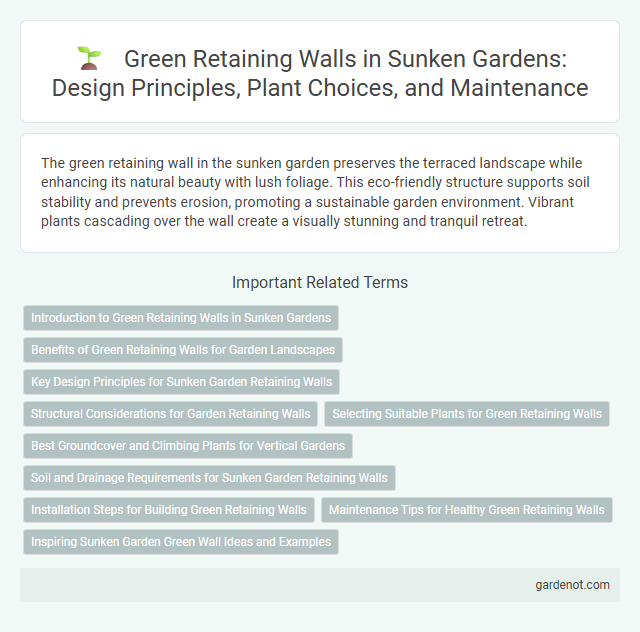The green retaining wall in the sunken garden preserves the terraced landscape while enhancing its natural beauty with lush foliage. This eco-friendly structure supports soil stability and prevents erosion, promoting a sustainable garden environment. Vibrant plants cascading over the wall create a visually stunning and tranquil retreat.
Introduction to Green Retaining Walls in Sunken Gardens
Green retaining walls in sunken gardens enhance soil stability while promoting biodiversity and improving air quality. These living walls use vegetation to reduce erosion, manage runoff, and create visually appealing, sustainable landscapes. Integrating native plants further supports local ecosystems, making green retaining walls an eco-friendly solution for sunken garden design.
Benefits of Green Retaining Walls for Garden Landscapes
Green retaining walls in garden landscapes enhance soil stability while reducing erosion and runoff, promoting a healthier ecosystem. They provide natural insulation, improving microclimate conditions for plants and reducing energy costs. Furthermore, these walls increase biodiversity by creating habitats for beneficial insects and birds, enriching the garden's overall sustainability.
Key Design Principles for Sunken Garden Retaining Walls
Green retaining walls in sunken gardens optimize space by integrating vegetation with structural stability, promoting erosion control and natural drainage. Key design principles include selecting drought-resistant plants, ensuring proper waterproofing, and incorporating modular panels for ease of maintenance and scalability. Effective root barriers and layered soil substrates enhance plant health while safeguarding the retaining wall's integrity.
Structural Considerations for Garden Retaining Walls
Structural considerations for green retaining walls in a sunken garden include soil pressure, drainage, and material strength to ensure stability and longevity. Proper reinforcement with geogrids or steel supports prevents wall failure under lateral earth loads, while effective drainage systems reduce hydrostatic pressure and soil erosion. Selecting durable, weather-resistant materials tailored to garden size and soil type optimizes wall performance and integrates seamlessly with the landscape.
Selecting Suitable Plants for Green Retaining Walls
Selecting suitable plants for a green retaining wall in a sunken garden requires focusing on species with strong root systems to stabilize the soil and prevent erosion. Native groundcovers, succulents, and drought-tolerant perennials such as creeping thyme, sedum, and ornamental grasses thrive well in these conditions while enhancing aesthetic appeal. Proper plant selection ensures ecological balance, reduces maintenance needs, and promotes long-term structural integrity of the retaining wall.
Best Groundcover and Climbing Plants for Vertical Gardens
Green retaining walls in sunken gardens thrive with groundcovers like creeping thyme and sedum, which prevent soil erosion while adding vibrant textures. Climbing plants such as English ivy, star jasmine, and clematis efficiently cover vertical surfaces, promoting biodiversity and enhancing aesthetic appeal. Optimal selection ensures healthy growth, requires minimal maintenance, and sustains moisture levels in the garden microclimate.
Soil and Drainage Requirements for Sunken Garden Retaining Walls
Green retaining walls in sunken gardens require well-draining soil to prevent water accumulation and ensure root health. A mixture of sandy loam combined with organic matter supports plant growth while facilitating adequate drainage. Incorporating proper drainage systems such as perforated pipes or gravel layers helps maintain soil stability and prevents erosion around the retaining structure.
Installation Steps for Building Green Retaining Walls
Green retaining walls installation begins with site assessment to ensure proper drainage and soil stability. Next, a sturdy framework of treated timber or reinforced concrete is constructed to support soil and vegetation layers. Finally, soil is layered with appropriate plants installed, followed by consistent watering and maintenance to promote healthy plant growth and wall longevity.
Maintenance Tips for Healthy Green Retaining Walls
Regular pruning and trimming are essential for maintaining a green retaining wall's health by preventing overgrowth and promoting airflow. Consistent irrigation using drip systems ensures roots receive adequate moisture without waterlogging, supporting robust plant growth. Periodic inspection for pests and diseases enables early intervention, preserving the wall's structural integrity and aesthetic appeal.
Inspiring Sunken Garden Green Wall Ideas and Examples
Sunken garden green retaining walls creatively combine functionality with lush aesthetics by using vertical planting systems that stabilize soil while enriching the garden's visual appeal. Examples include tiered green walls featuring native climbers and succulents that thrive in shaded conditions, providing a sustainable and vibrant backdrop. Incorporating eco-friendly materials like reclaimed wood or stone enhances the natural integration, inspiring homeowners to transform their sunken spaces into serene, living artworks.
Green retaining wall Infographic

 gardenot.com
gardenot.com